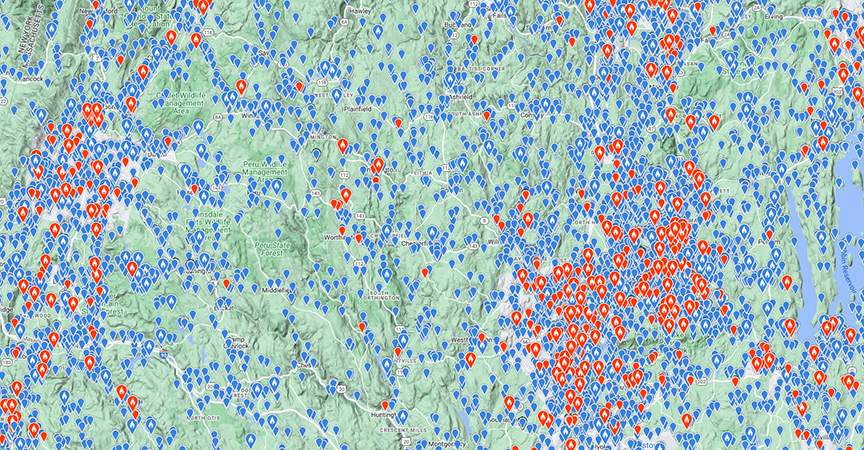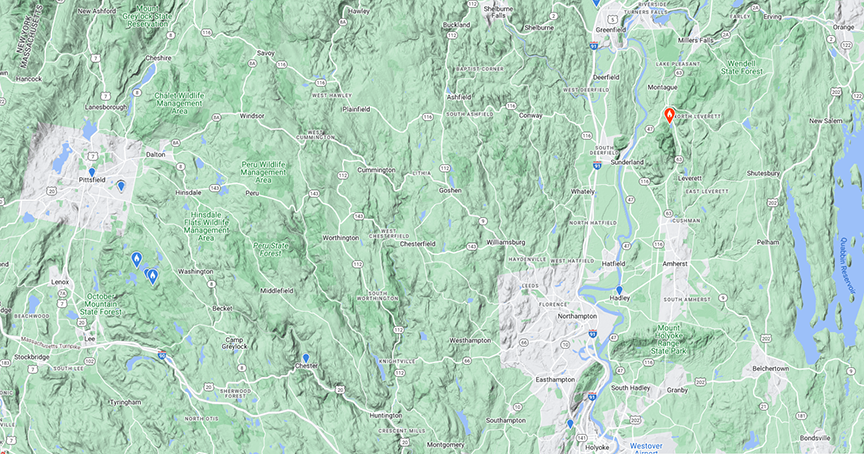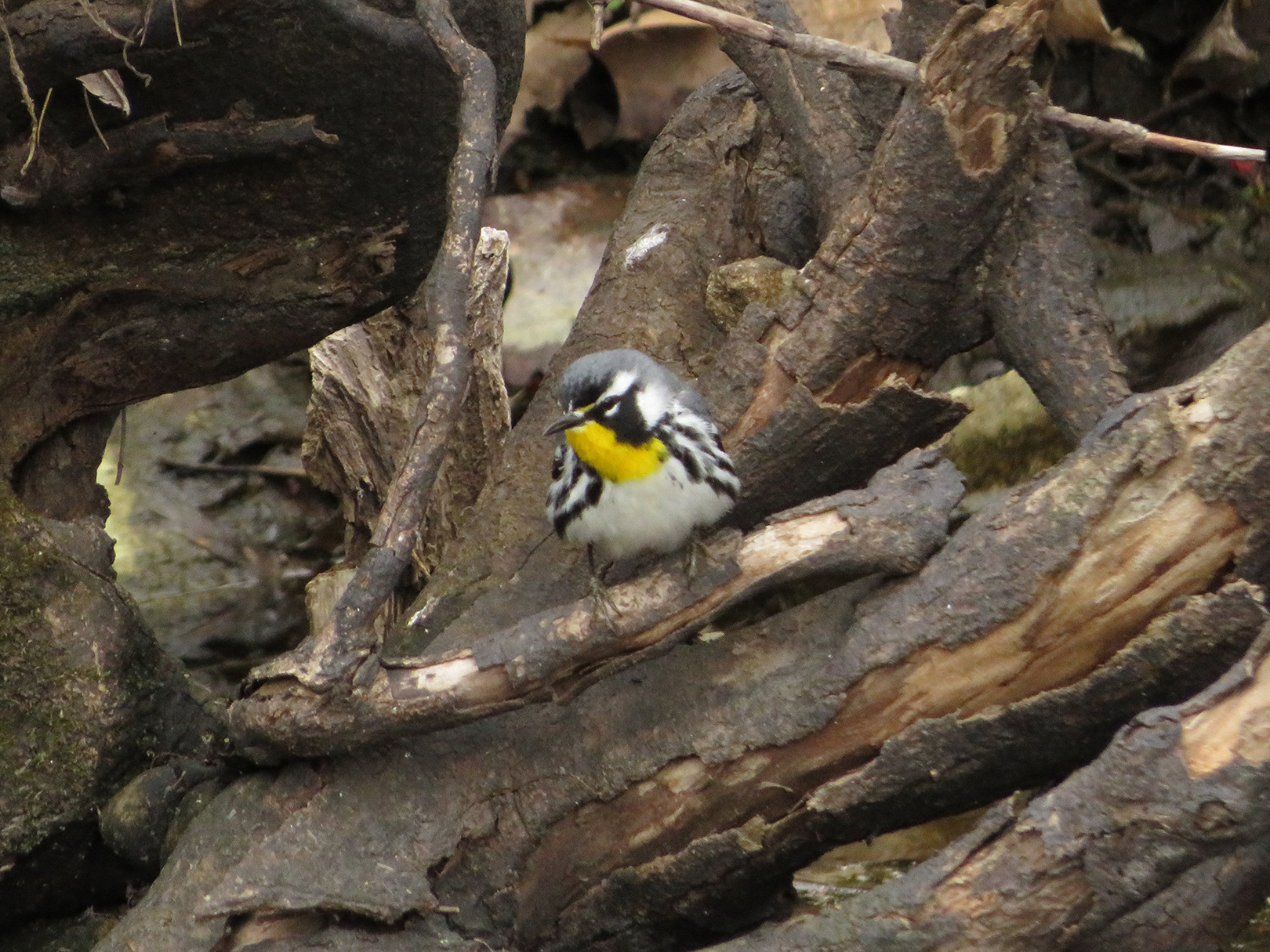Written by Mason –
In Western Massachusetts the Yellow-Throated Warbler, which I will also refer to as the YTW, is a “super rare find”. But what does that mean? Well, let’s set some baselines for bird rarities and to do that I first need to explain what eBird is.
The Cornell Lab of Ornithology launched eBird in 2002 as an online database that utilizes the globally loved activity of birding as an otherwise untapped citizen science resource. Although the project initially struggled to draw in users it quickly gained popularity as they added new features and it currently has over 1.4 billion bird observations on record globally. Important to note is that while the project launched in 2002, and the majority of observations have occurred from 2012 onwards, records dating back to 1900 are technically possible.
Okay, that’s eBird, so what about rarities? Well one of eBird’s features lets you search a given species and then view historical reports of that species anywhere on the world map.
The following maps show roughly the area from Greenfield to Holyoke and from the Quabbin to the MA/NY border. If you look at the first map we can see all the sightings ever reported of Blue Jays in this area. This is a very common bird, so common you can’t read the map due to all the location markers.
Taking a look at the second map, we have Baltimore Orioles over the same area. This is still not a rare bird by any stretch, however it is significantly less common and only present for part of the year.
Now viewing the last map we have the Yellow-Throated Warbler.
Aside from a report last week in Agawam that’s just out of frame, this is the entire history of YTWs in WMass. Only four have ever been reported in the Pioneer Valley. That’s a pretty stark contrast isn’t it?
Once I figured this all out I knew this sighting was special and yet I still wasn’t grasping the scope of my discovery.
On the morning that I found the YTW at Cranberry Pond I ended up running other errands and did not get home until after 5PM upon which I submitted my complete bird checklist to eBird. A complete checklist is a record of every single bird seen and heard during a given period of time at a specific location and date.
I then went and shared my findings with a WMass birding group on Facebook that I sometimes look at as I thought people there might be interested to see what I had found, especially given that I had decent photos where the ID of my bird was not in question.
The response was immediate and far beyond my expectations. The first person to comment on my post was Larry Therrien who I recognized as a name I’d seen on eBird while I randomly looked up historical sightings. He asked if I used eBird and if I did not he offered to submit the sighting and he would give me full credit. I said that I had just uploaded my full checklist an hour prior, though the YTW specifically wasn’t showing up on the map yet as it had been flagged as a rarity and needed review. Turns out Larry just happens to be an eBird checklist/sighting reviewer for Franklin, Hampshire, and Hampden counties and has been volunteering for eBird from almost the start as he knows several people involved in its creation.
Before the night was over Larry verified my sighting and we exchanged a few emails regarding specifics of the YTW’s location so that he could try to find it himself.
Meanwhile, the rest of the Facebook group were having a field day with my post. The last time someone had found a YTW in the area was when one frequented a bird feeder in Worcester from December 2020 to January 2021 which was very rare for a variety of reasons. Within the next 24 hours my post continued to generate more engagement than the past two weeks of posts combined, not including a notable exception of a super early Baltimore Oriole sighting in Northampton. Turns out other people had potentially seen it later that day although they had not gotten photos, and by the next day multiple people had returned to Cranberry Pond and successfully found it themselves and taken photos. At the same time another person had managed to take photos of a YTW in Agawam.
Having two YTW’s in the Pioneer Valley at the same time is unprecedented.
Larry was successful in finding the Warbler and made a blog post giving details about the bird and its history in WMass. Between his blog post and all the positive feedback and comments I’d been receiving on my post I was starting to realize there was more gravity to this finding than I’d first suspected.
I let this all sit for a few days and then my friend Daniel, who had been with me when I originally found the Wabler, asked if other people were still seeing the YTW around or if there were more.
I went to eBird and searched the species, and although no new locations appeared, when I opened the tag for Cranberry Pond my jaw dropped. I found the Yellow-Throated Warbler on Wednesday the 19th and by Saturday the 22nd twenty-one people had gone and also reported finding the same individual there. Twenty-one people went searching for a bird that they only knew about because I spoke up. That’s not even counting the people who went looking and didn’t find it, or the people who found it and didn’t report it on eBird.
Seeing the amount of impact that I had on the local birding community really made it stand out just how special this sighting was. Finding this Warbler and sharing it with eBird and the local birding community is the most significant and rare birding experience Daniel and I have ever had in our lives without a doubt, and it could take decades before either of us witness something more rare.
There are birders who go out of their way to chase rare sightings, and we were the ones who found the bird that gets those people excited. They are willing to drive hours just for a chance to see it. Daniel even had someone mention the YTW sighting to his parents, not realizing they knew one of the guys who originally found it. And during subsequent visits to Cranberry Pond, I met and had wonderful conversations with two birders both of whom were seeking out the YTW. When I spoke with one of them and mentioned I was the guy who originally found the YTW he already knew my name, and this was his 5th attempt at trying to see the bird as so far he’d only been able to hear it singing.
I’m not really sure how to conclude this. I could say something about you never know what you’ll find in nature until you step outside and wait a few minutes, however despite 100% knowing that to be true and having experienced wonderfully unexpected moments plenty of times, even I struggle with the motivation to get myself out there more often.
I guess what I could say is that even though in the moment, as my hands were numb from the cold, surrounded by a flock of Warblers knowing one of them was a species I’d never seen before, I knew it was special. And now that I’m grasping the full weight of what I got to witness and share with the world I can appreciate it for being substantially more impactful and rare, which is a true gift.
Mason has lived at Stowe Farm Community since 2014 and been a member since 2011





